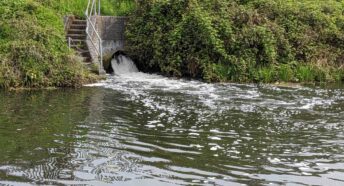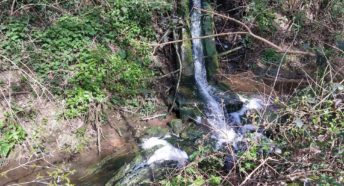Sewage spill data for 2023: what’s in our Hertfordshire waterways?
2023 saw more rainfall and that meant more sewage spilled into our county’s precious rivers and chalk streams. The data shows that water companies need to do more, more quickly, to improve operational performance and reduce the sewage polluting our waterways.
Sewage overflows into our waterways have been dominating the news over the last few months, and it’s no surprise. With prominent individuals like water campaigner Feargal Sharkey and comedian Joe Lycett helping to raise awareness, there is widespread public outcry about the poor water quality of England’s rivers.
How do sewage spills come about?
Sewage spills into our waterways when the storm overflows in our sewerage network are automatically activated by heavy rainfall or flooding. These storm overflows are a safety valve designed to prevent sewage from backing up into properties or onto streets, and they have been part of the sewerage network since it was first built. But with some sewage treatment works near their capacity, and with more rainfall, the storm overflows are activating more frequently.
Overall 2023 data for England
All across England there were high levels of rainfall in 2023. In fact it was provisionally the 6th wettest year since the Met Office data series began in 1836, according to the Environment Agency.
Consequently, there was far more sewage spilled into the waterways. Government data shows there was a 105% increase in the total hours’ duration of monitored sewage spills, from 1,754,921 in 2022 to 3,606,170 in 2023. And there was a 54% increase in the number of sewage spills that occurred, from 301,091 in 2022 to 464,056 in 2023.
These are shocking figures: over three-and-a-half-million hours of sewage flowing into our waterways last year.
It’s no wonder that The Rivers Trust in their latest State of Our Rivers report found that only 15% of river stretches in England were in good ecological health. (A river stretch is a short length of a river where measurement takes place.)
The 2023 data for Hertfordshire
CPRE Hertfordshire has analysed the government’s sewage spill (‘event duration monitoring’) data for 2023. This is available from the Environment Agency and is also mapped by The Rivers Trust and Top of the Poops.
The picture locally mirrors that across England, with significantly more sewage spilled into our waterways in 2023 than in 2022. Across all of Hertfordshire last year, there were over 800 spills resulting in the release of raw sewage into our waterways, for a total duration of over 7,800 hours, or the equivalent of 325 days’ continuous flow.
This affected all of our Hertfordshire chalk streams and rivers, many of their tributaries, and our three canals: the Grand Union, the Lee Navigation and the Stort Navigation.
The places with the greatest number of hours of sewage spills are shown here, in descending order by number of hours. (Source: Environment Agency)
| Place | Waterway | Number of Spills | Number of Hours |
| Cottered | Cottered Brook | 114 | 2222 |
| Brickendon | Harmonds Brook West Arm | 108 | 1390 |
| Weston | River Beane | 73 | 959 |
| Maple Lodge | Grand Union Canal | 52 | 650 |
| Barkway | River Quin | 44 | 627 |
| Therfield | River Rib | 32 | 244 |
| Berkhamsted | Grand Union Canal | 33 | 227 |
| Dagnall | Ground water | 38 | 223 |
| Widford & Wareside | River Ash | 16 | 175 |
| Ashwell | River Rhee | 24 | 165 |
| Hitchin | River Hiz | 95 | 160 |
| Hadham Mill | River Ash | 29 | 130 |
| W. End, Essendon | Wood Hill Brook | 11 | 112 |
| Ashbrook | Ash Brook | 12 | 81 |
| Chapmore End | River Rib | 31 | 80 |
| Hatfield, Mill Green | River Lea | 10 | 79 |
| Rye Meads | Toll House Stream | 13 | 62 |
| Buntingford | River Rib | 16 | 51 |
| Barley | Fowlmere Stream | 34 | 40 |
| Harpenden | River Lea | 4 | 35 |
| Standon | River Rib | 4 | 16 |
| Baldock | Ground water | 3 | 14 |
| Bishops Stortford | Stort Navigation | 5 | 14 |
| Caddington | Ground water | 3 | 14 |
| Essendon | River Lea | 3 | 14 |
| Whitwell | River Mimram | 2 | 12 |
| High Wych | High Wych Ditch | 4 | 11 |
| Pirton | River Hiz | 7 | 11 |
| Markyate | River Ver | 4 | 10 |
Cottered and Brickendon top the league table once again, as they did in 2022. At Cottered, with 2,222 hours of sewage spilling into Cottered Brook, that is over 25% of the time all year.
Is the data reliable?
But there are questions regarding the data for some locations. For example, in 2021, at Markyate there were 139 spills for a total of 2,642 hours into the River Ver. In 2022 and 2023 there were apparently few spills, but in 2024 from 1 January to 15 June there have already been over 2,300 hours of continuous sewage spills into the River Ver at Markyate, according to Sewage Map UK which is based on Thames Water’s real time storm discharge data.
There are other caveats with this data. Not all of the event duration monitoring sensors are accurate all of the time. And the data only reflects storm overflows. Recently the BBC has conducted an investigation into England’s water companies discharging sewage when the weather is dry. The investigation suggests 6000 possibly illegal spills occurred during 2022.
Sewerage infrastructure is a crucial planning issue
Here at CPRE Hertfordshire, we believe the damage being done to our rivers and their habitats has reached crisis point. The 2023 data and the events of the past few months of wet weather in 2024 suggest that existing sewerage infrastructure is already wholly inadequate to cope with current, let alone future population.
And with huge housing growth proposed across Hertfordshire, the sewerage infrastructure is now a crucial planning issue.
For example, the Maple Lodge sewage treatment works near Rickmansworth handles the sewage from Hemel Hempstead. The government data shows 650 hours of sewage spills during all of 2023. But we know from Thames Water’s data that in just the first three months of 2024 there were 1,090 hours of sewage being discharged at Maple Lodge – that is about 50% of the time. Dacorum Borough Council and St Albans District Council are currently proposing 11,000 new dwellings at ‘Hemel Garden Communities’ and yet the evidence suggests that the sewerage capacity just isn’t available.
Another example is the Rye Meads sewage treatment works, which handles much of the sewage from eastern Hertfordshire. But it is located immediately adjacent to the Lee Valley RAMSAR wetland site, which is a designated protected wildlife site of international importance. East Hertfordshire District Council has allocated sites for 10,000 new dwellings nearby around Gilston, and we question whether this is consistent with the legal imperative to protect the RAMSAR site.
What are we doing about this?
We call on Local Planning Authorities (Councils) –
- To use ‘pre-commencement’ planning conditions to prevent development from taking place until sufficient sewerage provision has been made for that specific development. This could include reinforcing the sewerage network, extending treatment capacity at a sewage works, improving surface water drainage, and reducing storm sewage overflows into the environment.
- To require developers to demonstrate that adequate sewerage infrastructure is in place before the first dwellings are occupied.
We call on Government –
- To give the Environment Agency the power to veto planning applications for which adequate sewerage infrastructure cannot be provided by the completion date of the first dwellings. This includes sewerage infrastructure provided by the developer and that provided by the sewerage company.
- To hold the Environment Agency to account for missed response time targets for investigating sewage spills. Data obtained under Freedom of Information laws shows that between the start of 2017 and the autumn of 2023, the Environment Agency arrived late to 74% of category 1 or 2 pollution incidents (2,550 cases in total) including sewage spills. These classifications are only given to incidents that have had “major” or “significant” effects on people, property or the environment. (Source: Greenpeace Unearthed; The Times)
- To put tighter restrictions on water companies to prevent sewage spills including holding these companies to account for managing storm overflows in line with legal and regulatory requirements.
- To require water companies to be transparent about their current sewerage operations and future programmes for sewerage provision including information on planned projects.
– – –
Please sign up below for our newsletter to stay up to date with all of our work to protect the countryside and the environment. Better yet, please join us – we are a membership charity and rely on membership subscriptions and donations to fund all of our work. We appreciate your help and support.






